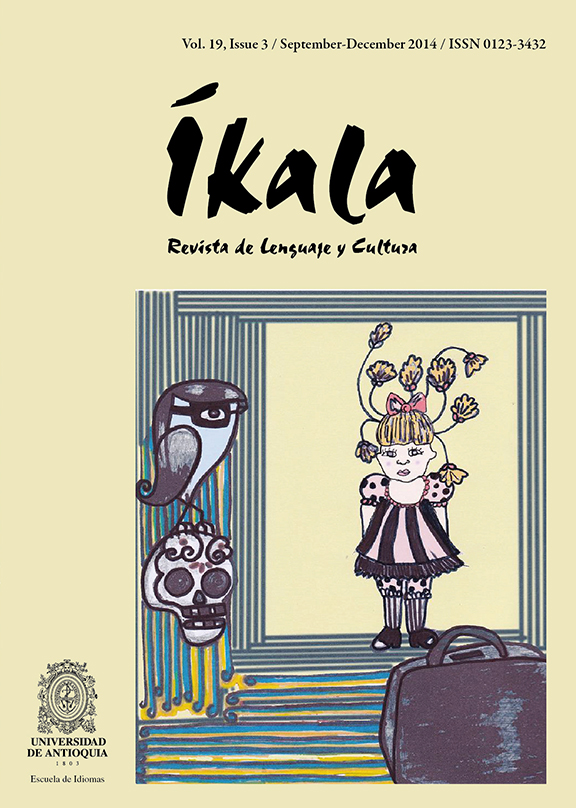Organisation d’un Réseau Académique – une Stratégie pour Promouvoir le Développement Professionnel
DOI:
https://doi.org/10.17533/udea.ikala.v19n3a07Keywords:
professional learning community, Professional development, teacher collaboration, network, communities of practice, researchAbstract
Downloads
References
Bolam, R., McMahon, A., Stoll, L., Thomas, S., & Wallace, M. (2005). Creating and sustaining effective professional learning communities. General Teaching Council for England. University of Bristol: England.
Caine, G., & Caine, R. N. (2000). The learning community as a foundation for developing teacher leaders. NASSP Bulletin, 84(616), 7-14.
DuFour, R. (2003). Building a professional learning community: For system leaders, it means allowing autonomy within defined parameters. The School Administrator. Retrieved March 8, 2008, from http://findarticles.com/p/articles/mi_m0JSD/is_5_60/ai_101173944
DuFour, R. (2004). What is a professional learning community? Educational Leadership, 61(8),6-11.
DuFour, R., Eaker, R., & Many, T. (2006). Learning by doing: A handbook for professional learning communities that work. Bloomington, IN: Solution Tree.
Eaker, R., & Gonzalez, D. (2006). Leading in professional learning communities. National EakerForum of Educational Administration and Supervision Journal, 24(1), 6-13.
Feger, S., & Arruda, E. (2008). Professional learning communities: Key themes from the literature. Providence, RI: The Education Alliance, Brown University.
Haneda, M. (2006) Classrooms as communities of practice: A reevaluation. TESOL QUARTERLY, 40 (4),807-817.
Harris, A. and Jones, M. (2010) Professional learning communities and system Improvement. Improving Schools, 13(2), 172-181. doi: 10.1177/1365480210376487
Henri R., & Pudelko B. (2003). Understanding and analyzing activity and learning in Virtual Communities. Journal of Computer Assisted Learning, 19(4), 474-487.
Hord, S. (1997). Professional learning communities: What are they and why are they important? Austin, TX: Southwest Educational Development Laboratory (SEDL).
Hord, S., & Rutherford, W. L. (1998). Creating a professional learning community: Cottonwood Creek School. Issues about Change, 6(2), 1-8.
Huffman, J. B. (2000). One school's experience as a professional learning community. Planning and Changing, 31(1-2), 84-94.
Huffman, J. (2003). The role of shared values and vision in creating professional learning communities. NASSP Bulletin, 87, 21-34.
Huffman, J. B., & Hipp, K. K. (2003). Reculturing schools as professional learning communities. Lanham, MD: Rowman & Littlefield.
Kline, M. (2007). Developing Conceptions of Teaching and Learning Within Communities of Practice. US: University of Pensylvania.
Lave, J., & Wenger, E. (1991). Situated learning: Legitimate peripheral participation. Cambridge, England: Cambridge University Press.
Louis, K., & Kruse, D. (1995). Professionalism and community: Perspectives on reforming urban schools. Thousand Oaks, CA: Corwin Press.
Martínez, M. C. (2006) La Figura del Maestro Como Sujeto Político. El Lugar de los Colectivos y Redes Pedagógicas en su Agenciamiento. Revista Educere, 10(33), 243 - 250.
McREL. (2003). Sustaining School Improvement: Professional Learning Communities. Retrived 10/05/13 from http://www.mcrel.org
Ministerio de Educación Nacional. (2004) Plan Sectorial de Educación 2010-2014. Documento 9.
Ministerio de Educación Nacional. (2013) Política y Sistema Colombiano de Formación y Desarrollo Profesional de Educadores. MEN.
National Staff Development Council (NSDC).(2001). Standards for staff development. Retrieved on 04/12/13 from http://www.nsdc.org
Pearson Education (2008) Report Pearson Learning Teams: Success Story los Angeles Unified School District Ten Schools Program.
Portal Colombia Aprende (2012) Comunidades de Colombia. Retrieved from http://www.comunidadescolombiaaprende.com/redes/all
Protheroe, N. (2008). Developing your school as a professional learning community. NAESP Research Roundup. Retrieved February 16, 2008, from http://www.naesp.org/ContentLoad.do?contentd=1094
Reichstetter, R. (2006). Defining a professional learning community: A literature review. E&R Research Alert, #06.05. Retrieved August 8, 2008, from http://www.wcpss.net/evaluation-research/ reports/2006/0605plc_lit_review.pdf
Stanley, A. (2011) Professional Development within Collaborative Teacher Study Groups: Pitfalls and Promises. Arts Education Policy Review, 112(2), 71-78.
Stoll, L., Bolam, R., McMahon, A., Wallace, M., & Thomas, S. (2006). Professional learning communities: A review of the literature. Journal of Educational Change, 7(4), 221-258.
The Center for Comprehensive Schools Reform and Improvement. (2013) Retrieved from http://www.centerforcsri.org/plc/
Universitat Autònoma de Barcelona. (2007). Spain case study report 4 Transforming Schools into Learning Communities: Social and cultural transformation. Barcelona: Spain.
Welsh Government. (2011). Professional Learning Communities. Guidance document No: 062/2011. Retrieved from http://learning.gov.wales/docs/learningwales/publications/130830-plc-guidanceen.pdf
Additional Files
Published
How to Cite
Issue
Section
License
Copyright (c) 2014 Íkala

This work is licensed under a Creative Commons Attribution-NonCommercial-ShareAlike 4.0 International License.












